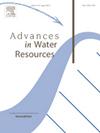Estimation of relative permeability curves in porous media induced by electroosmotic flow through pore-scale two-phase flow simulations
IF 4.2
2区 环境科学与生态学
Q1 WATER RESOURCES
引用次数: 0
Abstract
Given the limited research on two-phase electroosmotic flow within porous media, this paper conducts numerical simulations to investigate the pore-scale two-phase flow behavior and the relative permeability characteristics induced by electroosmotic flow. A two-phase slip velocity approximation model is employed to simulate water/oil two-phase electroosmotic flow in porous structures. The results indicate that, although the dragging capacity of the water phase increases with water saturation, the influence of capillary force and weak viscous coupling between small oil clusters and the water phase results in a non-monotonic trend in the relative permeability of the oil phase. Due to changes in the flow mechanism, the relative permeability of the water phase increases slowly before a certain level of water saturation. However, once the water saturation exceeds this threshold, the relative permeability of the water phase increases rapidly with further increases in water saturation. The increased flow resistance for the oil phase and the diminished electro-osmotic driving force for the water phase are the two primary factors responsible for the lowest oil-phase relative permeability observed in oil-wet porous media. The relative permeability curves for both the oil and water phases increase with the electric field strength under all three wettability conditions. Moreover, high electric field strength will reduce irreducible water saturation under water-wet conditions, but this phenomenon is not as pronounced under intermediate-wet and oil-wet conditions.
通过孔隙尺度两相流模拟估算电渗透诱导多孔介质的相对渗透率曲线
针对多孔介质内两相电渗流研究有限的现状,本文通过数值模拟研究了多孔介质内两相电渗流的孔隙尺度行为和电渗流诱导的相对渗透率特征。采用两相滑移速度近似模型模拟了多孔结构中水/油两相电渗透流动。结果表明,尽管水相的拖拽能力随着含水饱和度的增加而增加,但受毛细力的影响以及小油簇与水相之间的弱粘耦合,导致油相的相对渗透率呈现非单调趋势。由于流动机理的改变,水相的相对渗透率在达到一定含水饱和度之前增长缓慢。但是,一旦含水饱和度超过该阈值,随着含水饱和度的进一步增加,水相的相对渗透率迅速增加。油相流动阻力的增大和水相电渗透驱动力的减弱是导致油相相对渗透率最低的两个主要因素。在三种润湿性条件下,油相和水相的相对渗透率曲线均随电场强度的增大而增大。此外,在水湿条件下,高电场强度会降低不可还原的水饱和度,但在中湿和油湿条件下,这种现象并不明显。
本文章由计算机程序翻译,如有差异,请以英文原文为准。
求助全文
约1分钟内获得全文
求助全文
来源期刊

Advances in Water Resources
环境科学-水资源
CiteScore
9.40
自引率
6.40%
发文量
171
审稿时长
36 days
期刊介绍:
Advances in Water Resources provides a forum for the presentation of fundamental scientific advances in the understanding of water resources systems. The scope of Advances in Water Resources includes any combination of theoretical, computational, and experimental approaches used to advance fundamental understanding of surface or subsurface water resources systems or the interaction of these systems with the atmosphere, geosphere, biosphere, and human societies. Manuscripts involving case studies that do not attempt to reach broader conclusions, research on engineering design, applied hydraulics, or water quality and treatment, as well as applications of existing knowledge that do not advance fundamental understanding of hydrological processes, are not appropriate for Advances in Water Resources.
Examples of appropriate topical areas that will be considered include the following:
• Surface and subsurface hydrology
• Hydrometeorology
• Environmental fluid dynamics
• Ecohydrology and ecohydrodynamics
• Multiphase transport phenomena in porous media
• Fluid flow and species transport and reaction processes
 求助内容:
求助内容: 应助结果提醒方式:
应助结果提醒方式:


